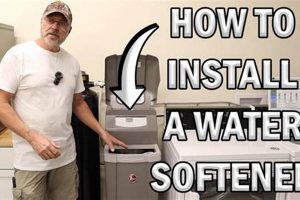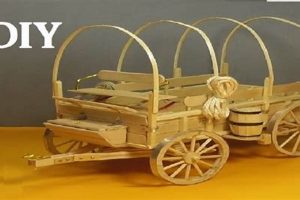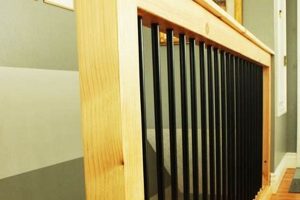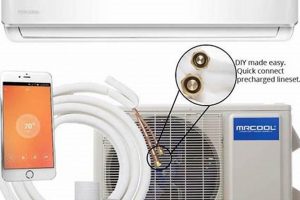The construction of novelty eyewear replicating the appearance of characters from popular animated media constitutes a crafting activity. This project typically involves readily available materials such as plastic pipes, elastic bands, and lenses fashioned from clear plastic sheets. The resulting product emulates the distinctive eye covering worn by the characters, often featuring a singular, large lens or a dual-lens configuration.
Engaging in such a project offers several advantages. It fosters creativity and resourcefulness, encouraging individuals to repurpose common household items. Furthermore, it provides an economical alternative to purchasing commercially manufactured character-themed accessories. Historically, the creation of homemade costumes and props has been a widespread practice, reflecting both affordability concerns and a desire for personalized expression.
The subsequent discussion will address specific techniques and materials commonly employed in realizing these character-inspired eye accessories. Detailed instructions regarding frame construction, lens fabrication, and strap attachment will be provided to facilitate successful project completion.
Construction Techniques and Material Selection
The following guidelines outline best practices for constructing character-themed novelty eyewear, emphasizing durability, safety, and aesthetic accuracy.
Tip 1: Frame Material Selection: Utilize rigid PVC pipe or similar thermoplastic materials for the frame. This ensures structural integrity and provides a stable base for lens attachment. Consider pipe diameter to achieve appropriate scale relative to the intended wearer.
Tip 2: Lens Fabrication: Employ clear acrylic sheets or polycarbonate for the lenses. These materials offer superior clarity and impact resistance compared to thinner, less durable alternatives. Ensure proper cutting techniques to avoid sharp edges.
Tip 3: Strap Attachment Security: Secure elastic straps using robust adhesives designed for plastic bonding. Mechanical fasteners, such as rivets or small screws, can further reinforce the attachment points to prevent strap detachment during use.
Tip 4: Paint Adhesion and Durability: Prior to painting, thoroughly clean and prime the frame surface to promote optimal paint adhesion. Utilize acrylic-based paints formulated for plastic surfaces to minimize chipping and fading.
Tip 5: Ventilation Considerations: For extended wear, incorporate small ventilation holes into the frame design to mitigate lens fogging. Position these openings discreetly to maintain the overall aesthetic.
Tip 6: Safety Precautions: Always deburr any sharp edges or corners on the frame and lenses. Ensure the eyewear fits comfortably and securely without causing pressure points or obstructing vision.
Tip 7: Accurate Proportions: Reference character design specifications to ensure accurate scale and proportion in the finished product. Precise replication enhances the overall visual impact.
Adhering to these recommendations promotes the creation of safe, durable, and visually appealing character-themed novelty eyewear, maximizing both aesthetic quality and user satisfaction.
The subsequent section will address potential challenges encountered during construction and offer troubleshooting strategies.
1. Material Acquisition
The acquisition of appropriate materials forms the bedrock of any successful project involving self-constructed character-themed eyewear. The selection process directly influences the final product’s durability, safety, and visual fidelity. Inadequate material sourcing can lead to structural instability, compromised aesthetics, and potential safety hazards.
- PVC Pipe Selection
PVC (polyvinyl chloride) pipe often serves as the primary frame component. Diameter selection dictates the overall scale of the eyewear. Thicker-walled pipes provide greater structural integrity, while thinner pipes offer greater flexibility. Considerations include the availability of compatible fittings for joining segments and achieving desired curvature. Incorrect diameter choice can result in an improperly sized or proportioned final product.
- Lens Material Procurement
Transparent materials such as acrylic sheets or polycarbonate are commonly used for lens fabrication. Acrylic offers good clarity and ease of cutting, while polycarbonate provides superior impact resistance. Thickness selection affects both clarity and structural integrity. Inadequate thickness may lead to lens cracking or shattering under stress. Sourcing from reputable suppliers ensures material quality and optical clarity.
- Elastic Strap Acquisition
Elastic straps are essential for securing the eyewear to the wearer’s head. Width and elasticity determine the comfort and adjustability of the fit. Low-quality elastic may lose its elasticity over time, resulting in a loose or insecure fit. Selecting UV-resistant elastic is crucial for outdoor applications to prevent degradation and premature failure. The choice of buckle or adjustment mechanism also affects ease of use and overall comfort.
- Adhesive and Fastener Procurement
Appropriate adhesives and fasteners are required for securely joining frame components, attaching lenses, and securing the elastic strap. Adhesives must be compatible with the chosen materials to ensure a strong and durable bond. Incorrect adhesive selection can result in component separation and structural failure. Mechanical fasteners, such as rivets or screws, offer additional reinforcement, particularly in high-stress areas. Corrosion-resistant materials are recommended to prevent degradation over time.
The interrelationship between these material acquisition facets highlights the importance of a holistic approach. Choosing substandard materials in any one area can negatively impact the overall project outcome, rendering the completed character-themed eyewear less durable, aesthetically pleasing, and potentially unsafe. Proper material sourcing is, therefore, a critical precursor to successful creation.
2. Frame Construction
Frame construction, within the context of creating cartoon character-themed novelty eyewear, constitutes a foundational stage that dictates the structural integrity and aesthetic realism of the finished product. This process involves selecting appropriate materials, employing precise cutting and shaping techniques, and ensuring secure and durable component assembly. The quality of the frame directly impacts the overall usability and visual appeal. For example, a poorly constructed frame may exhibit instability, leading to discomfort or even breakage during wear. Conversely, a well-constructed frame provides a solid foundation for lens integration and strap attachment, resulting in a more
authentic and durable recreation.
The selection of materials significantly influences the ease and effectiveness of frame construction. Rigid PVC pipe, commonly used for its affordability and workability, requires careful measurement and cutting to achieve accurate dimensions. Heat bending, a technique often employed to create the curved shape characteristic of certain characters’ eyewear, demands precise temperature control to avoid material deformation or weakening. Secure joining methods, such as solvent welding or mechanical fasteners, are essential for ensuring long-term structural integrity. A lack of attention to detail during these stages can result in misaligned components, weak joints, and a compromised overall appearance. The specific character being emulated also dictates the complexity of the frame construction. Single-lens designs, such as that of the Cyclops, present different challenges compared to dual-lens designs requiring precise alignment and symmetrical construction.
In summary, frame construction is not merely a preparatory step but an integral component of creating character-themed novelty eyewear. Its meticulous execution ensures both the structural stability and visual accuracy necessary for a successful and enjoyable finished product. Challenges related to material selection, shaping techniques, and joining methods must be addressed with precision to achieve a high-quality outcome, highlighting the practical significance of a thorough understanding of this fundamental construction phase. The quality of the frame forms the basis for the success of subsequent steps in the construction process.
3. Lens Fabrication
Lens fabrication represents a critical stage in the creation of character-themed novelty eyewear. The process directly impacts visual clarity, safety, and the overall aesthetic realism of the final product. Proper execution involves careful material selection, precise cutting and shaping techniques, and secure integration into the frame structure.
- Material Clarity and Selection
The choice of lens material fundamentally affects visual clarity. Optically clear acrylic or polycarbonate sheets are preferred, providing unobstructed vision and minimizing distortion. Examples include using cast acrylic for its superior clarity compared to extruded acrylic, or opting for polycarbonate when impact resistance is paramount. Inadequate material selection can result in blurred vision, eye strain, or even increased risk of injury from shattering lenses. Specifically, inexpensive plastics may yellow or degrade over time, reducing visibility.
- Cutting and Shaping Techniques
Precise cutting and shaping are essential for achieving accurate lens geometry. Laser cutting or CNC routing offer high precision, ensuring a consistent and accurate fit within the frame. Manual cutting methods, while less precise, require careful measurement and skilled execution. Improper cutting techniques can lead to gaps between the lens and frame, compromising structural integrity and aesthetic appeal. Moreover, sharp edges on improperly cut lenses present a safety hazard.
- Lens Tinting and Coating Applications
Lens tinting or coating can enhance visual comfort and aesthetic realism. Tinting reduces glare and provides added protection from sunlight. Coating applications, such as anti-scratch or anti-fog treatments, improve durability and visibility in various environmental conditions. The application of inappropriate coatings can result in visual distortions or reduced light transmission. For example, applying a mirrored finish may significantly impair visibility in low-light conditions.
- Secure Integration and Retention
Secure integration of the lens within the frame is crucial for both structural integrity and safety. Adhesives, mechanical fasteners, or a combination of both are typically employed. The adhesive must be compatible with both the lens and frame materials to ensure a strong and durable bond. Improper lens retention can lead to lens detachment during use, posing a potential hazard. Mechanical fasteners, such as small screws or rivets, offer added security, especially in high-stress applications.
Lens fabrication, therefore, necessitates a balanced approach, prioritizing visual clarity, safety, and aesthetic accuracy. The selection of appropriate materials, the application of precise cutting techniques, and the implementation of secure integration methods collectively contribute to the creation of high-quality character-themed novelty eyewear. Attention to these details significantly enhances the overall user experience and visual appeal of the finished product.
4. Strap Attachment
Strap attachment, within the context of constructing character-themed novelty eyewear, directly impacts usability and wearer safety. A secure and appropriately adjusted strap system ensures the eyewear remains stable during movement, preventing slippage or accidental dislodgement. Inadequate strap attachment can lead to discomfort, impaired vision, or, in extreme cases, potential injury if the eyewear detaches unexpectedly. The connection is causal; a poorly attached strap system invariably results in compromised functionality.
The importance of secure strap attachment is underscored by several practical considerations. Firstly, children often wear such eyewear, necessitating a robust and reliable attachment mechanism to withstand energetic activity. Secondly, the weight and distribution of the eyewear frame can exert significant stress on the attachment points, particularly with larger or more elaborate designs. Thirdly, the material of the strap itself influences the effectiveness of the attachment; elastic straps require secure anchoring to prevent stretching and slippage, while non-elastic straps demand adjustable buckles for a comfortable and personalized fit. For example, employing a weak adhesive to attach an elastic strap to a rigid PVC frame will likely result in premature failure, rendering the eyewear unusable. Similarly, attaching a non-adjustable strap without considering head size variations can lead to discomfort and instability.
In summary, strap attachment is a critical component in the creation of functional and safe character-themed novelty eyewear. Its effectiveness hinges on careful material selection, robust attachment techniques, and consideration of wearer-specific factors. Ignoring this aspect can undermine the overall quality and usability of the project, highlighting the practical significance of understanding its impact. The secure and comfortable fit provided by a properly executed strap attachment system ultimately contributes to a positive and safe user experience.
5. Painting Technique
Painting technique significantly impacts the aesthetic fidelity and durability of self-constructed character-themed novelty eyewear. The selection of appropriate paints, surface preparation methods, and application techniques directly contribute to the visual realism and longevity of the finished product. Inadequate painting practices can result in a lackluster appearance, premature paint chipping, or even material degradation.
- Surface Preparati
on and PrimingSurface preparation, including cleaning and priming, is crucial for promoting optimal paint adhesion. Removing surface contaminants and applying a compatible primer creates a uniform base for subsequent paint layers. Failure to properly prepare the surface can lead to poor paint adhesion, resulting in chipping, peeling, or blistering. For example, neglecting to sand smooth the PVC surface before painting can result in a textured finish and reduced paint durability. Application of a plastic-specific primer ensures the paint bonds effectively to the substrate.
- Paint Selection and Compatibility
The selection of appropriate paints, specifically those formulated for plastic substrates, is essential for achieving a durable and visually appealing finish. Acrylic-based paints are commonly used for their flexibility, durability, and colorfastness. The use of non-compatible paints, such as solvent-based paints on certain plastics, can lead to material degradation or cracking. For instance, enamel paints may not adhere well to PVC, resulting in a brittle and easily damaged finish. Selecting paints with UV resistance is also crucial for outdoor applications to prevent fading and discoloration.
- Application Methods and Layering
The application method and layering technique directly influence the uniformity and coverage of the paint finish. Applying thin, even coats prevents runs and drips, resulting in a smooth and professional appearance. Multiple layers may be necessary to achieve the desired color saturation and opacity. Examples include using an airbrush for a consistent and even application or applying multiple thin coats of paint with a brush to avoid thick, uneven patches. Allowing each layer to fully dry before applying the next coat prevents blistering and ensures proper adhesion.
Effective painting technique, therefore, encompasses a comprehensive approach, prioritizing surface preparation, appropriate paint selection, and skillful application methods. Adherence to these principles ensures the creation of character-themed novelty eyewear that is not only visually appealing but also durable and resistant to wear and tear. The overall aesthetic quality of the final product is directly correlated to the proficiency with which these painting techniques are employed, contributing significantly to the realism and enjoyment derived from the self-constructed eyewear.
6. Safety Adherence
Safety adherence is paramount in projects involving the construction of novelty eyewear, particularly when replicating designs intended for children. This encompasses material selection, construction techniques, and intended use, all of which directly influence the potential for injury.
- Material Toxicity Assessment
Material selection must prioritize non-toxic substances, mitigating the risk of chemical exposure through skin contact or ingestion. Paints, adhesives, and plastics should be certified as non-toxic, particularly if the eyewear is intended for use by young children. Examples include selecting water-based acrylic paints over solvent-based alternatives and ensuring plastics are BPA-free. Neglecting material toxicity assessment can result in allergic reactions, skin irritation, or more severe health consequences.
- Structural Integrity and Impact Resistance
The structural integrity of the eyewear is critical for preventing breakage and potential injury. Lens materials should possess adequate impact resistance to withstand minor impacts without shattering. Frames should be constructed from durable materials and securely fastened to prevent component separation. For instance, using thin, brittle plastic for lenses can result in sharp fragments upon impact, posing a significant hazard. Reinforcing frame joints with robust adhesives or mechanical fasteners enhances overall structural integrity.
- Vision Impairment Mitigation
The design of the eyewear should minimize potential vision impairment. Lenses must be clear and free from distortion to avoid eye strain or reduced visual acuity. Tinted lenses should be used with caution, as they can reduce visibility in low-light conditions. Similarly, obstructed peripheral vision can increase the risk of accidents. Rigorous testing of lens clarity and field of view is essential to ensure safe and comfortable use.
- Proper Fit and Securement
Ensuring a proper fit and securement is crucial for preventing slippage or accidental dislodgement of the eyewear. Straps should be adjustable and made from non-irritating materials. The frame should sit comfortably on the face without causing pressure points or obstructing breathing. For example, a strap that is too tight can restrict blood flow and cause discomfort, while a strap that is too loose can allow the eyewear to slip, potentially causing injury. Regular adjustments and inspections are necessary to maintain a secure and comfortable fit.
These interconnected facets of safety adherence underscore the importance of a comprehensive and proactive approach to risk mitigation. By prioritizing non-toxic materials, robust construction techniques, minimal vision impairment, and proper fit, the creation of character-themed novelty eyewear can be undertaken with a reduced risk of potential injury. Consistent adherence to these safety principles is paramount for ensuring the well-being of the intended wearer.
7. Scale Accuracy
Scale accuracy represents a critical determinant of the visual authenticity and overall success of do-it-yourself novelty eyewear resembling the accessories worn by animated characters. Proper scaling ensures the finished product harmonizes with recognizable design elements, enhancing the illusion and believability of the replica.
- Overall Proportionality
The relative dimensions of the frame, lenses, and strap are essential for achieving visual coherence. Disproportionate elements, such as oversized lenses on a slender frame or an excessively wide strap, detract from the intended aesthetic. For instance, replicating eyewear with a 1:1 scale relative to character illustrations ensures immediate recognition. Deviations from accurate proportions can render the accessory unrecognizable or aesthetically unappealing, negating the desired effect.
- Lens Diameter and Curvature
Lens diameter directly influences the perceived size and shape of the character’s eyes. Deviations from the intended diameter can alter the character’s expression, resulting in an inaccurate portrayal. Similarly, precise curvature replication contributes to the three-dimensional realism of the eyewear. Employing a lens with an insufficient curvature can flatten the appearance, diminishing the immersive effect. For example, a lens intended to be hemispherical requiring accurately reproduced curvature for correct visual impact.
- Frame Thickness and Profile
The thickness and profile of the frame contribute to its structural integrity and visual weight. Exaggerated thickness can make the accessory appear bulky and unwieldy, while insufficient thickness compromises durability. Accurately replicating the frame’s profile ensures it conforms to the character’s distinctive design. For instance, specific animated eyewear may feature a beveled or rounded frame edge; the accurate replication
of these details greatly enhances the overall aesthetic authenticity. - Strap Width and Positioning
The width and positioning of the strap on the frame affect both comfort and visual accuracy. An excessively wide strap can overwhelm the frame, while an insufficient width compromises stability. Precisely positioning the strap attachment points relative to the frame ensures a secure and balanced fit. Deviations from accurate strap positioning can lead to discomfort or misalignment, detracting from the intended aesthetic.
The interrelation of these scaling factors emphasizes the importance of a holistic design approach. Deviations in one area can disproportionately impact the overall visual impact of the finished product. By meticulously attending to each of these scaling details, constructors of novelty eyewear can produce replicas that accurately capture the essence of the source material, resulting in a more convincing and enjoyable final product.
Frequently Asked Questions
The following addresses common inquiries regarding the construction and safe use of character-themed novelty eyewear, specifically those resembling a certain animated character’s goggles.
Question 1: What materials are best suited for constructing a durable frame for DIY minion goggles?
Rigid PVC pipe offers a balance of durability, workability, and affordability. Thermoplastic materials with comparable strength are acceptable alternatives. Avoid using thin or easily deformable plastics that may compromise structural integrity.
Question 2: How can clarity be maximized when fabricating lenses for DIY minion goggles?
Opt for optically clear acrylic or polycarbonate sheets. Ensure the chosen material is free from scratches or imperfections. Cutting and polishing techniques should minimize distortion and maximize light transmission.
Question 3: What safety precautions are essential when constructing DIY minion goggles?
Prioritize non-toxic materials. Deburr all sharp edges and corners. Ensure proper ventilation to prevent fogging. Thoroughly test the structural integrity of all components before use.
Question 4: How can strap slippage be prevented in DIY minion goggles?
Securely attach elastic straps using robust adhesives designed for plastic bonding. Reinforce attachment points with mechanical fasteners, such as rivets. Employ adjustable buckles to accommodate varying head sizes.
Question 5: What type of paint is recommended for DIY minion goggles, and how can chipping be minimized?
Utilize acrylic-based paints specifically formulated for plastic surfaces. Thoroughly clean and prime the surface before painting. Apply thin, even coats to promote optimal adhesion and durability.
Question 6: How can scale accuracy be ensured when constructing DIY minion goggles?
Reference character design specifications and maintain accurate proportions throughout the construction process. Employ precise measuring tools and techniques to minimize discrepancies. Verify the overall dimensions against established benchmarks.
The above guidelines are intended to promote safe and effective construction practices. Diligence in material selection, construction techniques, and safety precautions is crucial for achieving a satisfactory outcome.
The next section will summarize key takeaways and offer concluding remarks.
Conclusion
The preceding discussion has detailed various facets of crafting novelty eyewear. Key areas explored include material selection, frame construction, lens fabrication, strap attachment, painting techniques, safety adherence, and scale accuracy. Effective implementation across these areas contributes to a successful outcome.
Diligent application of the outlined principles is essential. Those undertaking the construction of such novelty items are advised to prioritize safety and precision. The resulting products, when executed correctly, can serve as both recreations and expressions of creativity.







